

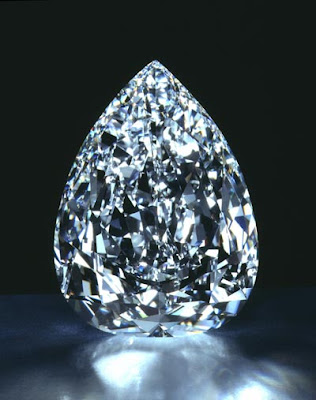 The Millennium Star is internally and externally flawless pear-shaped diamond (total of 54 facets). With the weight of 203.04 carats it is the 10th largest diamond in the world. Originally, the rough stone was 777 carats found in the Mbuji-Mayi district of Zaire (Democratic Republic of the Congo) in 1990. After 5 months of studying and planning the cutting of the stone, it was decided to cut the rough diamond into three pieces. The Millennium Star is the outcome of the largest piece. The value of the stone hasn't been revealed but the Millennium Star was insured for 100 million English pounds, this is believed to be a fraction of its true worth.
The Millennium Star is internally and externally flawless pear-shaped diamond (total of 54 facets). With the weight of 203.04 carats it is the 10th largest diamond in the world. Originally, the rough stone was 777 carats found in the Mbuji-Mayi district of Zaire (Democratic Republic of the Congo) in 1990. After 5 months of studying and planning the cutting of the stone, it was decided to cut the rough diamond into three pieces. The Millennium Star is the outcome of the largest piece. The value of the stone hasn't been revealed but the Millennium Star was insured for 100 million English pounds, this is believed to be a fraction of its true worth. The Red Cross is canary yellow cushion-shaped diamond with weight of 205.07 carats. The rough stone weighed 375 carats and was found in Kimberly mines (South Africa) in 1901. The diamond was presented as a gift to the art sale held in London by Christies in 1918, on behalf of the British Red Cross Society and the Order of St. John. Another rare feature is that a Maltese Cross is distinctly visible in the top facet, hence the double appropriateness of its name, the Red Cross Diamond.
The Red Cross is canary yellow cushion-shaped diamond with weight of 205.07 carats. The rough stone weighed 375 carats and was found in Kimberly mines (South Africa) in 1901. The diamond was presented as a gift to the art sale held in London by Christies in 1918, on behalf of the British Red Cross Society and the Order of St. John. Another rare feature is that a Maltese Cross is distinctly visible in the top facet, hence the double appropriateness of its name, the Red Cross Diamond.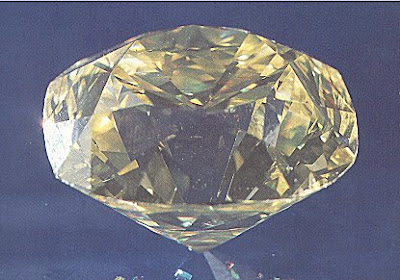 The De Beers diamond was found in Kimberly mines in 1888, the rough stone weighed 428.50 carats and measured 47.6 mm through its longest axis and 38.1 mm square. Weighing 234.65 carats, the De Beers is the 8th largest faceted diamond in the world. After its display in Paris the Maharaja of Patiala bought the De Beers. In 1928 Cartier of Paris set it as the centerpiece of a ceremonial necklace that came to be known as the Patiala Necklace. The necklace originally contained about 2,930 diamonds weighing about 962.25 carats. Today's whereabouts of the De Beers diamond and the Patiala Nacklace is unknown.
The De Beers diamond was found in Kimberly mines in 1888, the rough stone weighed 428.50 carats and measured 47.6 mm through its longest axis and 38.1 mm square. Weighing 234.65 carats, the De Beers is the 8th largest faceted diamond in the world. After its display in Paris the Maharaja of Patiala bought the De Beers. In 1928 Cartier of Paris set it as the centerpiece of a ceremonial necklace that came to be known as the Patiala Necklace. The necklace originally contained about 2,930 diamonds weighing about 962.25 carats. Today's whereabouts of the De Beers diamond and the Patiala Nacklace is unknown.
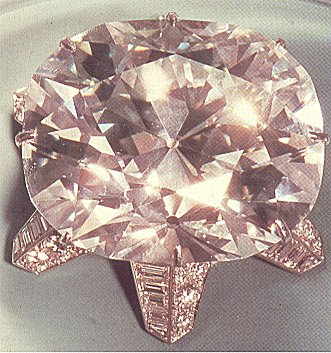 The Jubilee is a colorless cushion-shaped diamond with a weight of 245.35 carats. The original rough stone, an irregular octahedron without definite faces or shape weighed 650.80 carats and was found in the Jagersfontein Mine towards the end of 1895. When during the cutting it became evident that a superb diamond of exceptional purity and size was being produced, it was planned to present it to Queen Victoria. In the end this did not happen and the diamond remained with its owners. The following year marked the Diamond Jubilee of Queen Victoria (the 75th anniversary of her coronation) so the gem was renamed the Jubilee to commemorate the occasion.
The Jubilee is a colorless cushion-shaped diamond with a weight of 245.35 carats. The original rough stone, an irregular octahedron without definite faces or shape weighed 650.80 carats and was found in the Jagersfontein Mine towards the end of 1895. When during the cutting it became evident that a superb diamond of exceptional purity and size was being produced, it was planned to present it to Queen Victoria. In the end this did not happen and the diamond remained with its owners. The following year marked the Diamond Jubilee of Queen Victoria (the 75th anniversary of her coronation) so the gem was renamed the Jubilee to commemorate the occasion. The Centenary was found in Premier mine in 1986, in its rough form it weighed 599 carats. When cutting was completed the Centenary weighed 273.85 carats, measured 39.90 × 50.50 × 24.55 mm, and had 247 facets - 164 on the stone and 83 around its girdle. Never before had such a high number of facets been polished onto a diamond. The true value of the Centenary diamond is unknown, but the diamond was insured for around $100 million in 1991.
The Centenary was found in Premier mine in 1986, in its rough form it weighed 599 carats. When cutting was completed the Centenary weighed 273.85 carats, measured 39.90 × 50.50 × 24.55 mm, and had 247 facets - 164 on the stone and 83 around its girdle. Never before had such a high number of facets been polished onto a diamond. The true value of the Centenary diamond is unknown, but the diamond was insured for around $100 million in 1991. The Spirit of de Grisogono, at 312.24 carats, is the world's largest cut black diamond, and world's 5th largest diamond. In a white gold mounting, it is set with 702 white diamonds totaling 36.69 carats. This diamond originally had a rough weight of 587 carats and was mined several decades ago in west Central Africa before being imported into Switzerland.
The Spirit of de Grisogono, at 312.24 carats, is the world's largest cut black diamond, and world's 5th largest diamond. In a white gold mounting, it is set with 702 white diamonds totaling 36.69 carats. This diamond originally had a rough weight of 587 carats and was mined several decades ago in west Central Africa before being imported into Switzerland.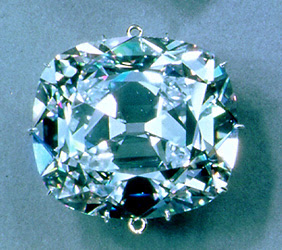 The Cullinan II is the massive 317.40 carat cushion shaped diamond in the center-front of the Imperial State Crown of Great Britain. Cullinan II was cut from the largest gem-quality diamond ever found, it weighed 3106 carats, or about 1 1/3 pounds. It was named after Sir Thomas Cullinan, who opened the mine and was visiting on that eventful day. The nine larger stones of the Cullinan diamond remain either in the British Crown Jewels or in the personal possession of the Royal Family.
The Cullinan II is the massive 317.40 carat cushion shaped diamond in the center-front of the Imperial State Crown of Great Britain. Cullinan II was cut from the largest gem-quality diamond ever found, it weighed 3106 carats, or about 1 1/3 pounds. It was named after Sir Thomas Cullinan, who opened the mine and was visiting on that eventful day. The nine larger stones of the Cullinan diamond remain either in the British Crown Jewels or in the personal possession of the Royal Family. The Incomparable, in its rough state weighing 890 carats, was found in the town of Mbuji Mayi in the Democratic Republic of Congo (formerly Zaire) in the 1980s. Four years were spent studying and then cutting the stone, the biggest piece of rough ultimately yielded a gem weighing 407.48 carats; it is the third largest diamond ever cut. Internally flawless clarity and fancy brownish-yellow in color, it measures 53.90 × 35.19 × 28.18 mm.
The Incomparable, in its rough state weighing 890 carats, was found in the town of Mbuji Mayi in the Democratic Republic of Congo (formerly Zaire) in the 1980s. Four years were spent studying and then cutting the stone, the biggest piece of rough ultimately yielded a gem weighing 407.48 carats; it is the third largest diamond ever cut. Internally flawless clarity and fancy brownish-yellow in color, it measures 53.90 × 35.19 × 28.18 mm. The Cullinan I, a pear shaped diamond weighing 530.20 carats is also known as the Star of Africa. It measures 53mm x 44mm x 29mm, and has 76 facets. It's called the Cullinan I because it is the largest of 9 large stones cut from the 3106 carat Cullinan Diamond. Cullinan I was placed by King Edward in the Sovereign's Royal Sceptre as part of the Crown Jewels, and it is now on display in the tower of London. Estimated value of Cullinan I is over $400 million!
The Cullinan I, a pear shaped diamond weighing 530.20 carats is also known as the Star of Africa. It measures 53mm x 44mm x 29mm, and has 76 facets. It's called the Cullinan I because it is the largest of 9 large stones cut from the 3106 carat Cullinan Diamond. Cullinan I was placed by King Edward in the Sovereign's Royal Sceptre as part of the Crown Jewels, and it is now on display in the tower of London. Estimated value of Cullinan I is over $400 million!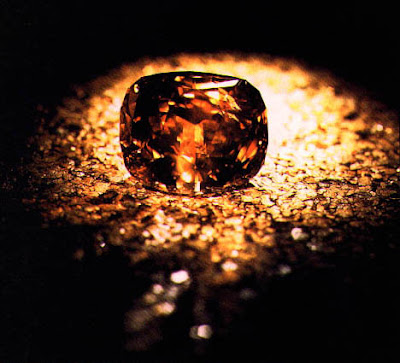 The Golden Jubilee, with the weight of 545.67 carats, is the largest faceted diamond in the world. Rough stone weighed 755 carats and was discovered in Premier mine, South Africa in 1985. The Golden Jubilee was presented to the King of Thailand in 1997 for his Golden Jubilee - the 50th anniversary of his coronation. Prior to this event, the stone was simply known as the Unnamed Brown. Estimated value of the Golden Jubilee is $4-$12 million.
The Golden Jubilee, with the weight of 545.67 carats, is the largest faceted diamond in the world. Rough stone weighed 755 carats and was discovered in Premier mine, South Africa in 1985. The Golden Jubilee was presented to the King of Thailand in 1997 for his Golden Jubilee - the 50th anniversary of his coronation. Prior to this event, the stone was simply known as the Unnamed Brown. Estimated value of the Golden Jubilee is $4-$12 million.
Payne's Custom Jewelry
 Diamond Turtle Engagement Ring | Having diamonds set in your custom jewelry design adds to it's value and makes the piece a very special jewelry creation. Let jewelry designer Tony Payne make your custom jewelry ideas become a reality. Tony has been creating unique diamond custom jewelry for over 20 years which includes over 9 years of custom jewelry Internet sales. All the jewelry pictured on this site was custom made by Tony for his Internet customers. If you have always wanted a ring or pendant design made with diamonds, he can expertly make it to your specifications. Email him at tony@paynesjewelry.com with any of your custom jewelry questions or design ideas. All custom jewelry price quotes are free. Tony's toll free phone number is 1 (866) 509-9199. Please call between 8 AM and 6 PM CDT Monday through Saturday. |
| Custom jewelry is usually designed on paper and is then carved from wax. This wax model is then destroyed by extreme heat in the casting process. This process is called "lost wax casting". The How Custom Jewelry is Made page has a detailed discussion of this jewelry making process. The jewelry designer custom carves each wax model individually, making each item as unique as the person receiving it. Your creation could be almost any type of jewelry design. Tony can make a sketch of the piece for your approval. During the process he can send you pictures through email of how your custom jewelry is being made. This one on one service helps to ensure that you get a very special piece of custom diamond jewelry to treasure for many years to come. | 
Custom Amethyst Pendant with Diamonds |
 Custom Championship Ring in White Gold with Diamonds | The prices for custom designed jewelry depends on the complexity of the design, what precious metal is used and whether gemstones are included in your design. For a simple custom ring the labor charge to carve, cast and finish begins at $250. The labor charge for a simple custom made pendant starts at $150. The labor charge for a championship or class ring with lettering or a design on the top and both sides begins at $1,200. The price of the metal will depend on the type and its weight, as well as current market conditions. Your custom design can be cast in either sterling silver, yellow or white gold or platinum. Diamonds and other gemstones can be provided to use in your custom jewelry at a reasonable price. Email Tony at tony@paynesjewelry.com and he will give you a free price quote based on your individual custom jewelry needs. Tony's toll free phone number is 1 (866) 509-9199. Please call between 8 AM and 6 PM CDT Monday through Saturday. All custom jewelry price quotes are free. |
The Orlov
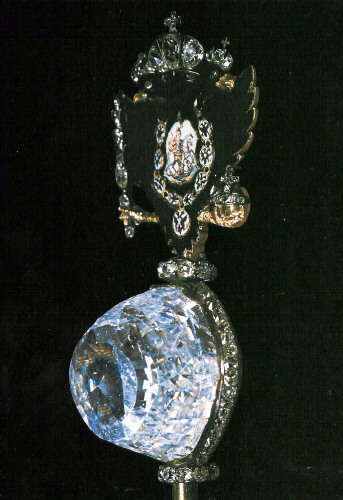
Legend, fact, supposition and theory each must be accorded its place in any historical account of this celebrated diamond. Nowadays the Orlov is one of the most important items in one of the greatest collections of gems and jewelry, the Treasures of the Diamond Fund, Gokran, cromprises of many historical jewels that were amassed by the rulers of Russia before the 1917 Revolution, as well as some of the exceptional diamonds unearthed during the past three decades that testify to Russia's current position as a leading world diamond producer.
The Orlov is mounted in the Imperial Sceptre, made during the reign of Catherine the Great (1762-96). Its weight has been recorded as 189.62 metric carats and it measures 47.6 mm in height, 31.75 mm in width, and 34.92 mm in length. The clarity is typical of the finest Indian diamonds and its color possesses a slight bluish-green tint. The shape of the diamond has been described as resembling half a pigeon's egg and its upper surface is marked by concentrated rows of triangular facets, with corresponding four-sided facets appearing on the lower surface. The total number of facets is roughly 180. On one side of the diamond there exists a slight indentation.
The unusual shape of the Orlov, the pattern of its facets and the presence of this blemish intriguingly suggest that this diamond can be indentified with a long-lost legendary stone.
Among the first Europeans who were permitted to examine the gems of the Mogul rulers of India was Jean Baptiste Tavernier, who provided illustrations of several stones he had seen in his work Six Voyages of Jean Baptiste Tavernier.
Tavernier's drawing of the diamond which has come to be known as the Great Mogul is of particular interest and importance, because it is the only one of this legendary stone known to have survived. According to all the available accountds of its history the Great Mogul was found about the middle of the 17th century in the Kollur diamond deposits situated by the Kristna (or Krishna) River in Hyderabad, and weighed no less than 787½ carats. In due course it found its way into the Mogul treasury and was shown to Tavernier by Aurangzeb (1658-1707), the third son of Shah Jahan, who had successfully fought off the challenge of his three brothers and usurped his father's throne. The cutting of the Great Mogul was entrusted to an Italian, Hortensio Borgio, who reduced the weight of the stone to 279 and 9/16 carats. The results of the efforts of the cutter, however, so displeased Aurangzeb that instead if rewarding him for his services, he fined him 10,000 rupees and would have extracted more had the wretched man possessed it. Tavernier makes several references to the Great Mogul, which are included under that entry.
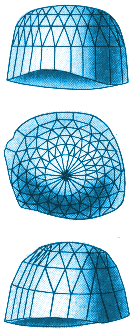
It is clear that the Great Mogul was the leviathan of all old Indian diamonds and that it was appreciated as such. But the mystery remains: what fate could have befallen such a great gem of which all trace appears to have been lost. Some have suggested that it was cut into smaller gems. Others suggest that it does exist today in the guise of another diamond, and the names of three in particular have been put forward: the Darya-I-Nur, the Koh-I-Noor, and the Orlov.
The contents of the Iranian Treasury were opened up in the 1960s for examination and cataloguing by three Canadian experts, among them V.B. Meen, who wrote a book about them titled The Crown Jewels of Iran. Their researches demonstrated that the Darya-I-Nur, the most important gem in the whole collection, bears no resemblance whatsoever to the Great Mogul. The Darya-I-Nur is light pink in color, while its flat, oblong shape has been demonstrably proved by the Candians to have been fashioned from the so-called Great Table Diamond which figured as No. 3 in Tavernier's set of drawings.
The evidence for indentifying the Koh-I-Noor with the Great Mogul is stronger. When the diamond was brought to England in 1850, drawings were made that showed its diameter approximated to that of the Great Mogul. The gem was considerably flatter but it showed the surfaces wence portions had been removed by cleavage. On the other hand, some authorities have always maintained that the existence of of the Koh-I-Noor had been known long before the advent of the Great Mogul and have identified it as the great diamond owned by Babur (1483-1530), the first of the Mogul dynasty. Babur reigned about a century and a half before Aurangzeb. It us unlikely that anyone will ever know for certain one way or the other the truth about the earliest history of the Koh-I-Noor.
There remains the Orlov. When a comparison is made between Tavernier's drawing of the Great Mogul and the photographs of the diamond in the Kremlin, it immediately becomes apparent there are similarities. The first lies in the shape. It will be recalled that the Orlov has been described as resembling half a pigeon's egg and that Tavernier refered to the Great Mogul as presenting 'the form of an egg cut in half.' Throughout history there cannot have been many diamonds of such an unusual form. Secondly, the pattern of facets of the two stones is not disimilar. Thirdly, the previously-mentioned slight indentiation that exists in the Orlov must correspond to Tavernier's note to that effect that 'there is a slight crack and a little flaw in it.' In addition, as will be shortly shown, the story of the Great Mogul would appear to have no known ending and that of the Orlov has no clear beginning - further historical evidence that they are probably one and the same diamond.
On the other hand, there is the discrepancy between the weights of the two stones. After being cut by the Venetian, Borgio, the Great Mogul's weight was reduced to around 280 carats, whereas the Orlov is estimated to be less than 200 carats. In this connection two points must be made. First, it has been shown by others that Tavernier may not always have recorded with accuracy the weights of the various stones he examined; for example, it is almost certain that he erred in the weight he gave for the Great Table Diamond. Secondly, it is not at all unlikely that at some point in its complicated history a further attempt may have been made to alter the state of the Orlov - to improve upon the efforts of Hortensio Borgio, by grinding away a portion of the top of Tavernier's diamond to resemble the shape of the Orlov today.
Finally, the Soviet authority on gems, Academician Alexander E. Fersman, who examined all the former Crown Jewels from a gemological point of view, was in no doubt that the Orlov was the same diamond as the Great Mogul. Personally, I also believe they are the same stone, recut.
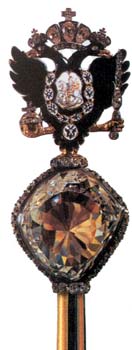
According to one account, the earliest known fact about the Orlov is that it was set as one of the eyes of an idol in a sacred temple in the south of India. This temple is stated to have been situated at a site alternatively spelled by past authors as 'Srirangen', 'Sherigan', 'Scheringham', and ' Sheringham'. But its true location is Srirangam, a town in the Tiruchirapalli (Trichinopoly) district of Madras which stands on an island formed by the tranching of the Cauvery River, about 3.2 km north of Tiruchirapalli city. The island, measuring 27 km long and 1.5 to 2 km wide, was strategically important as a base during the struggle between the English and French forces for Trichinopoly in the 18th century.
The great temple at Srirangem, dating from the 17th century, is dedicated to Vishnu and is reguarded as one of the most sacred shrines in southern India. It is composed of seven rectangular enclosures, one within another, the outermost having a perimeter exceeding 11.25 km in length. A remarkable feature is the Hall of a Thousand Pillars, with its colonnade of rearing horses.
A French soldier, who deserted and found employment in the neighborhood of Srirangem, learned that the temple contained the celebrated idol of a Hindu god, the eyes of which formed by two large diamonds of inestimable value. Thereupon he made a plan to seize the gems, a feat which necessitated years rather than months of planning, since no Christian was ever admitted beyond the fourth of the seven enclosures. So in order to effect his evil purpose, he embraced the Hindu faith and eventually obtained employment within the walls of the temple. By degrees he gained the confidence of the unsuspecting Brahmins and was allowed in as a frequent worshipper at the inner shrine, because of his apparent veneration for this particular divinity. Ultimately, he secured the appointment of guardian to the innermost shrine within which lay the object of his attention.
Then came the moment for which the Frenchman had waited so long, a stormy night that masked the idol in fitful shadows. He laid his sacrilegious hands upon the diety entrusted to his care and prized one of the diamond eyes out of its socket. Losing courage, he then fled the scene leaving the other diamond behind. He scaled the walls of the temple, swam the river and escaped into the surrounding jungle to the comparative safety of the English army encamped at Trichinopoly, and all the while the tempest raged. Finally, he made his way to Madras, where he sold the diamond for £2000 to an English sea captain who brought it to London and sold it to a Jewish merchant for £12,000. The merchant, in turn, is said to have sold it to an Armenian by the name of Khojeh Raphael, who had left Persia as a young man, sailed to Surat and then travelled by sea to England and then to Russia, passing through Amsterdam. Apparently, his travels had taken him to most European countries before he decided to settle as a merchant in the Italian port of Leghorn. According to a Persian traveller, Khojeh was 'a complete old scoundral, who had seen a great deal of this world and understood a number of languages.'
This colorful account of the Orlov cannot be relied upon as authorative. The real point of interest concerns the identity of the second diamond in the idol. Which diamond could possibly have been set as the eye? The candidates are few, with the Koh-I-Noor being foremost amongst them, but we know that this historic gem had been taken from Delhi in 1739 by the Persian Nadir Shah. Perhaps the second eye of the idol had filled by some other precious stone or had the idol itself at some time suffered the same fate as Nelson at Calvi?
Another version of the Orlov's journey to Europe is even more lurid. This account begins with the diamond belonging to the Mogul rulers and being amongst the loot carried off from Delhi by the Persians under Nadir Shah. Shortly after Nadir Shah had been murdered in 1747, an Afghan soldier, formerly in his service, appeared in Bassorah, a large town situated on the Shatt-el-Arab, some 112 km north of the Persian Gulf. The original city of Bassorah, of Thousand and One Nights fame, was founded by Caliph Omar I in AD 636, some 13 km from the modern city of Basra, which, like its predecessor, is an important port and trading center for produce from the east.
As well as the diamond, the Afghan brought with him many other expensive jewels, all of which he offered to an Armenian merchant named Grigori Safras, then residing with his two brothers in Bassorah. Safras was astonished at such a valuable hoard in the hands of a poor soldier who was obviously unaware of its true value. He was obliged to postpone the chance of doing business with the soldier in order to find sufficient funds. In the mean time, the Afghan became suspicious of the merchant's delay and, believing that a trap was being laid for him, disappeared from the city as mysteriously as he had entered.
The soldier made his way to Baghdad where he met a Jewish trader to whom he sold his treasures for 65,000 piastres (then about £500) and two fine Arab horses. But instead of returning home, he proceeded to squander his newly acquired riches in a bout of dissipation. Unfortunately, in the middle of his revels he met up again with Safras who this time determined not to lose site of the man. Disappointed to learn that the Afghan had sold his treasure, however, he was able to learn the whereabouts of the trader's residence, and lost no time in calling on him. Safras offered the merchant twice the amount he had paid for the diamond but the trader was unwilling to part with it. Thereupon Safras had consulted his two brothers who had joined him in Baghdad; they decided to acquire the diamond by foul means. Having successfully accomplished this, it became obvious that the Afghan would also need to be disposed of, because his evidence would incriminate the brothers. So, taking advantage of his liking for riotous living, they induced him to join them the next day for a bout of drinking during the course of which they administered poison. The bodies of the Jewish trader and Afghan soldier were placed together in a sack and thrown by night into the River Tigris.
The slaughter had not yet finished. Events had run smoothly for the murderers up to that point, but when it came time to the distribution of the plunder, each of the three brothers insisted on having the diamond. As it was impossible to divide the gem into three equal parts, and as neither of his brothers was prepared to waive his claim, the wily Safras treated them in exactly the same way that they had treated their unfortunate victims. So Safras perpetuated a double fratricide and another sack was dumped into the Tigris. After such a spate of killings, the Armenian wisely considered it prudent to move on; accordingly he made his way to Constantinople, then through Hungary to Silesia, before arriving in Amsterdam. Here he set himself up as a dealer in precious stones. One can only hope that the city's pre-eminence as a trading center was what attracted him, rather than its aqueous situation.
Now according to Edwin Streeter's book The Great Diamonds of the World, this second version of the history of the Orlov Diamond does not refer to the Orlov at all, but to a totally different diamond called the Moon of the Mountains, which weighed 120 carats. However, no trace of such a diamond exists today, least of all in the Russian Diamond Fund. In addition the Russian authorities have brought to light records which indicate that around 1768 their great diamond had indeed passed into the hands of an individual named Safras. Moreover they have also refered to the city of Astrakhan in their account of Orlov, a reference which is possibly explained by Streeter.
He states that after setting up in Amsterdam as a dealer, Safras drew the attention of certain European rulers, among them Catherine the Great of Russia, to his jewels. The Empress was apparently much taken by the description of the Armenian's great diamond, and invited Safras to her capital, St. Petersburg, where she put him in touch with the Court jeweler, I.L. Lazarev. Negotiations broke down over an agreed price for the gem, the amount being requested by Safras considered exorbitant. However, Count Panin, the favorite minister of the Empress at the time, proved equal to the occasion and ultimately showed himself more than a match for the astute Armenian. The demands of Safras were neither agreed to nor rejected; instead he was gradually led into a style of living with proved beyond his means, with the result that he ran heavily into debt. When his means were exhausted, Panin abruptly terminated the negotiations and informed Safras that he could not leave Russia, or even St. Petersburg, until all his creditors had been paid. Safras was thus at the mercy of the minister; nevertheless he was determined not to sacrifice his diamondand he succeded in raising enough money to settle his outstanding debts by selling other gems among the Armenian community in St. Petersburg. Thereupon he withdrew from the Russian capital.
A few years later the Russian Court learned that Safras was residing in Astrakhan and negotiations were reopened for the sale of the diamond, which he was induced to part with, apparently on the original terms. However, at this point in the diamond's history there is yet more confusion. It has always been thought that the diamond's much travelled purchaser bought the gem in Amsterdam; there were reports in the London press to that effect. So the conclusion to be drawn is that the business was not successfully completed in Astrakhan - Count Orlov had to travel to Amsterdam to finalize the arrangements. By this time the gem had become known as the Amsterdam Diamond.
Count Grigorievich Orlov (1723-83) was a Russian nobleman and an army officer of great distinction. He was wounded no less than three times during the various campaigns of the Seven Years War. On one occasion he was detailed to escort an important Prussian officer as a prisoner-of-war to St. Petersburg where in 1759 he was presented to the Grand Duke Peter and his consort, Catherine. Leading a riotous life in the capital, he caught the fancy of the Grand Duchess and became her lover. After the accession of Catherine's husband to the throne as Peter III, Orlov and his younger brother, Count Aleksei Grigorievich, organized the coup of July, 1762 whereby the weak Peter III was dethroned in favor of Catherine and then murdered.

Catherine appointed her lover adjutant-general, director-general of engineers and general-in-chief, but Count Panin, who was her political mentor, frustrated the intention of the Empress to marry Orlov. Continuing to serve Catherine in various capacities, Orlov became deeply resently when she took Aleksander Vassilchikov, then Grigori Potemkin, as lovers in his place. He left Russia in 1775.
Two years earlier Orlov had visited Amsterdam where he came to learn of the existence of Safras' great diamond. He bought it for a sum reputed to have been 1,400,000 florins, equivalent to 400,000 roubles. Such a purchase, doubtless, would have been made both to remind Catherine of the role which Orlov had played in her accession to the throne and hopefully to restore himself in her favor. This possibility appeared even stronger at the time, because Catherine herself had refused to accept Safras' original asking price for the diamond to the Empress on her Saint's Day; she accepted it and had it set in the Imperial Sceptre, designed by Troitnoki, immediately beneath the golden eagle. The Empress gave Orlov a marble palace at St. Petersburg, but she never rewarded him with his former position as her favorite. In 1777 Count Orlov married his cousin, but following her death in Lausanne in 1782, he became mentally deranged and returned to Russia to die the following year.
Interestingly, there is supposed to exist a document signed by both Orlov and Lazarev, the court jeweler at St. Petersburg, which places an entirely different interpretation upon the circumstances surrounding the former's purchase of the diamond. The Russian author suggest that the role of Count Orlov was merely that of a go-between in the transaction and that it was Catherine the Great who purchased the diamond. The Empress employed intermediaries for two reason: first, she wished to contrast her own alleged 'German frugality' (she had been born a German princess) with the reckless spending habits of her predecessors, and secondly, she considered that it would not have been proper for a monarch to bargain over the purchase price - something which Orlov himself could do. And it was for this service to the Empress that Orlov earned the honor of giving his name to the diamond.
There is a legend concerning the diamond, dating from the time of Napoleon. As the Emperor of France's forces were approaching Moscow during the campaign of 1812, the Orlov was secreted in the tomb of a priest in the Kremlin. When Napoleon entered Moscow he gave orders that the gem be sought. After he learned of its whereabouts, Napoleon in person, accompanied by his bodyguards, proceeded to the Kremlin to secure the diamond. The tomb was opened to reveal the great gem. One of the bodyguards stretched out a hand to take the diamond, but before he had touched it the ghost of the priest rose up and cursed the invaders. Napoleon and his bodyguards are then suppose to have fled empty-handed from the Kremlin. Now, on almost all counts this would appear to be nothing more than legend, but it adds yet one more detail to this already complex and most colorful story. Sources: Famous Diamonds by Ian Balfour, The Nature of Diamonds by George E. Harlow, Precious Stones by Max Bauer, Diamonds - Myth, Magic, and Reality by Ronne Peltsman, Neil Grant and about 22 contributing specialists/authorsRecent Research on the Napoléon Diamond Necklace
This historic diamond necklace (Figure 1) was the subject of a recent study which was published in "Gems and Gemology" (Gaillou E., Post J.E., "An examination of the Napoléon Diamond Necklace". Gems and Gemology, vol. 43, no.4, issue Winter 2007). Presented here is a summary of the history of the necklace and the main results obtained during the study.

History
Napoléon Bonaparte presented this magnificent necklace to his second wife, Marie-Louise, Empress of France, as a gift to celebrate the birth of their son, the emperor of Rome, in 1811 (Figure 2). The necklace was designed and assembled by the jewelry firm Nitot and Sons of Paris and complete in June 1811 for the fee of 376,274 French francs. Following the fall of Napoléon and his exile to Saint Helena in 1815, Marie-Louise returned to her Hapsburg family in Vienna, Austria, with her personal jewels, including the diamond necklace. After her death, the necklace passed to her cousin, Archduchess Sophie, her sister-in-law, who removed two diamonds from the necklace in order to shorten it and put them into earrings, the current whereabouts of which are unknown. Following the Archduchess’s death in 1872, the necklace was inherited by her three surviving sons, one of whom, Charles Louis, later acquired the interests of his two brothers. Charles Louis’s third wife, Maria Theresa, inherited the Napoléon necklace upon his death in 1914.
In 1929, Archduchess Maria Theresa sent the jewel to the United States to be sold. But the agents she chose to sell the necklace were not the persons they claimed to be, i.e. "Colonel Townsend," who had allegedly served in the British Secret Service, and "Princess Baronti," a novelist. In fact, the Townsends' true identities have never been confirmed. The necklace arrived in American at about the same time as the stock market crash, and the Townsends quickly realized that they never would be able to sell the necklace for the $450,000 asking price. The couple engaged Archduke Leopold, Marie-Theresa’s grand-nephew, who was from the ruined branch of the Hapsburg family and who worked in New York as a "sausage sailor man", in order to authenticate the necklace to prospective buyers. The Townsends negotiated deals to sell the necklace several times, and eventually sold it for $60,000 to David Michel, a New York diamond dealer. The Townsends sent $7,270 to Maria Theresa and kept the balance to cover their "expenses related to the sale," which included a reported $20,000 for Archduke Leopold. The affair ultimately went to court, as Maria Theresa had engaged an emissary to retrieve the diamonds and had revoked the Townsends’ authority to sell the necklace. The necklace was returned to Maria Theresa, Archduke Leopold went to jail, and the Townsends took flight and were never seen again.
In 1948 the necklace was sold by the Hapsburg family to French dealer Paul Weiller, then to the New York diamond dealer Harry Winston and finally to Mrs. Marjorie Merriweather Post. In 1962, she gave the necklace, in its original case (Figure 3) to the Smithsonian Institution.

The Napoléon necklace contains 234 colorless diamonds, totaling ~263 ct, set in silver and gold, with the largest stone weighting ~10.4 ct. It consists of 28 brilliant oval-cut diamonds from which are suspended a fringe of nine pendeloques, and 10 briolette diamonds. Additionally, there are five small brilliants mounted above five of the pendeloques, and the other four pendeloques are attached to motifs decorated with 23 and 12 brilliants, respectively (Figure 4). Each of the briolettes are set with 12 "roses de Hollande" diamonds.

The diamonds have never been graded, because they have never been removed from their settings. There are obvious crystalline inclusions in some of the diamonds, mostly what appear to be disc-shaped tension halos around sulfide crystals (Figure 5).

We examined 101 of the 234 diamonds by infrared spectrometry (Figure 6), as diamonds are classified by this method. This classification separates diamonds with nitrogen impurities (type I) from those without (type II). The classes are further subdivided depending on the nitrogen aggregation for type I (type Ia with aggregated nitrogen present, or Ib with only isolated nitrogen) and if boron is present for type II (type IIa if there is no boron, and type IIb if there is). Our study revealed that the proportion of the rare type IIa diamonds was higher than usual: 13 of the 52 larger diamonds are type IIa (Typically, fewer than 10% of natural diamonds are type II.). The others are the more common type Ia diamonds.

Type IIa diamonds exhibit characteristic features between crossed polarizers (Figure 7); strain features, "tatami graining", appear as banded and cross-hatched extinction patterns with first order interference colors of gray to blue.

Viewing the necklace under ultraviolet light reveals a large proportion of fluorescent diamonds, mostly with a blue color (Figure 8). Only a few (7) diamonds exhibit a pinkish-orange fluorescence; these diamonds are also type IIa, and are commonly referred to as Golconda-type diamonds (which usually have a light pink color that is not observed here).

Conclusion
In addition to its status as an historic icon, our study of the Napoléon Necklace revealed that it also contains some gemologically interesting diamonds. Infrared spectroscopy indicated that the majority of the primary diamonds in the Napoléon Necklace are of the rare type IIa, and are of a high-quality consistent with the jewel’s imperial pedigree. Apparently, the standards used 200 years ago to select the finest diamonds are similar to those still used today. The necklace is equally spectacular under ultraviolet light, and the diamonds’ luminescence behaviors correlate with their types. The Napoléon Necklace is one of the most spectacular diamond jewelry pieces of its period, and as part of the Smithsonian’s National Gem Collection, it along with its story is preserved for future generations.
[ TOP ]
| From myths about valleys of diamonds protected by snakes, to the production of millions of carats in rough diamonds each year, the history of diamonds is one of mystical power, beauty and commercial expertise. |
| |
| Early History The first recorded history of the diamond dates back some 3,000 years to India, where it is likely that diamonds were first valued for their ability to refract light. In those days, the diamond was used in two ways-for decorative purposes, and as a talisman to ward off evil or provide protection in battle. |  | |
| The Dark Ages |
| |
| The Middle Ages
|
| |
| The popularity of diamonds surged during the Middle Ages, with the discovery of many large and famous stones in India, such as the Koh-I-Noor and the Blue Hope. Today India maintains the foremost diamond polishing industry in the world.
|  | |
| As the Indian diamond supply dwindled, smaller finds occurred in Borneo and Brazil, but these were not sufficient to meet the ever-increasing demand for diamonds. The mid-nineteenth century discovery of diamonds near the Orange River in South Africa sparked the world's biggest diamond rush, and helped to satiate the world's increasing appetite for diamonds. |  | |
| Recent Times During the mid-nineteenth century, diamonds were also being discovered in eastern Australia. However, it was not until late 1970's, after seven years of earnest searching, that Australia's alleged potential as a diamond producer was validated. |  | |
| On October 2nd 1979, geologists found the Argyle pipe near Lake Argyle: the richest diamond deposit in the world. Since then, Argyle has become the world's largest volume producer of diamonds, and alone is responsible for producing over a third of the world's diamonds every year. |
|